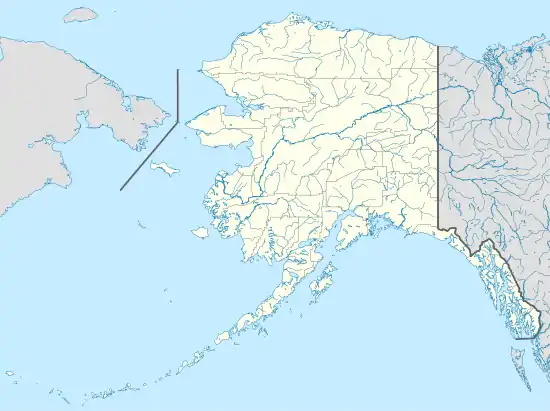Sledge Island
Sledge Island, or Ayak Island, is a small island in the Bering Sea. It is located 5.3 mi (8.5 km) from the southwestern shore of the Seward Peninsula, off the shores of Alaska.

Geography
Sledge Island is of volcanic origin and is only 1.6 miles (2.6 km) across.[1] The average elevation is 410 feet/125 meters.[2] Administratively this island belongs to the Nome Census Area, Alaska.
The island is 2.80 km (1.74 mi) long and 1.48 km (0.92 mi) wide.
The island is part of the Bering Sea unit of the Alaska Maritime National Wildlife Refuge.
History
This island was named on August 5, 1778, by Captain James Cook, who commented: "We found, a little way from the shore where we landed, a sledge, which occasioned this name being given to the island."[3] Martin Sauer, the secretary of the 1791 Russian expedition who sailed under orders from Catherine II of Russia, claimed in 1802 that the Inuit name of this island is "Ayak."
Captain Frederick Beechey observed: "It is singular that this island, which was named Sledge Island by Captain Cook, from the circumstances of one of these implements being found upon it, should be called by a word signifying the same thing in Esquimaux language."[4]
The island was featured in 2017 season 8 of Bering Sea Gold, as a site to prospect and mine for seafloor placer gold.[5]
Demographics
| Historical population | |||
|---|---|---|---|
| Census | Pop. | %± | |
| 1880 | 50 | — | |
| 1890 | 67 | 34.0% | |
| U.S. Decennial Census[6] | |||
Sledge Island first appeared on the 1880 U.S. Census as the unincorporated Inuit village of Aziak.[7] All 50 of its residents were Inuit. It returned again in 1890 as Sledge Island, with 67 residents (all native). However, this included the residents of the island (listed as the village of "Ahyak") and three adjacent small villages on the mainland, including Okinoyoktokawik, Senikave & Sunvalluk.[8] These were located approximately 19–20 miles west of present-day Nome, near a feature called West Point.[9] It has not reported in any census since.
References
- Tom Cade (1952). "Notes on the Birds of Sledge Island, Bering Sea, Alaska". The Condor. 54 (1): 51–54. doi:10.2307/1364528. JSTOR 1364528.
- "Sledge Island".
- James Cook (1842). The Voyages of Captain James Cook. William Smith. p. 329.
- Frederick William Beechey (1831). Narrative of a Voyage to the Pacific and Beering's Strait: To Co-operate with the Polar Expeditions Performed in His Majesty's Ship Blossom Under the Command of Captain F. W. Beechey, R. N., F. R. S. &c. in the Years 1825, 26, 27, 28. Colburn and Bentley. p. 400.
- "Uncharted Waters". Bering Sea Gold. Season 8. Episode 1. 1 February 2017. Discovery Channel.
- "U.S. Decennial Census". Census.gov. Retrieved June 6, 2013.
- http://www2.census.gov/prod2/decennial/documents/1880a_v1-17.pdf
- http://www2.census.gov/prod2/decennial/documents/1890a_v8-01.pdf
- "Geological Survey Professional Paper". 1949.